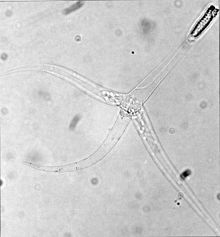- Myxozoa
-
Myxozoa 
Triactinomyxon stage of Myxobolus cerebralis. Scientific classification 
Kingdom: Animalia Phylum: Cnidaria (unranked): Myxozoa
Grassé, 1970Classes - Malacosporea
- Myxosporea
The Myxozoa (etymology: Greek: μυξ myx- "slime" or "mucus" + ζώα zoa "animals") are a group of parasitic animals of aquatic environments. Over 1300 species have been described[1] and many have a two-host lifecycle, involving a fish and an annelid worm or bryozoan. The average size of a Myxosporea spore usually ranges from 10 μm to 20 μm[2] and Malacosporea up to 2 mm. Infection occurs through valved spores. These contain one or two sporoblast cells and one or more polar capsules that contain filaments which anchor the spore to its host. The sporoblasts are then released as a motile form, called an amoebula, which penetrates the host tissues and develops into one or more multinucleate plasmodia. Certain nuclei later pair up, one engulfing another, to form new spores.
Contents
Phylogenetics
The Myxozoa were originally considered protozoan,[3] and were included among other non-motile forms in the group Sporozoa.[4] As their distinct nature became clear through 18S ribosomal DNA (rDNA) sequencing, they were relocated in the metazoa. Further classification was hindered by conflicting evidence: although 18S rDNA suggested an affinity with Cnidaria,[5] other rDNA sampled,[6][7] and the HOX genes of two species,[8] were more similar to those of the Bilateria.
The discovery that Buddenbrockia plumatellae, a worm-like parasite up to 2 mm in length, is a myxozoan[6] appeared to strengthen the case for a bilaterian origin, as the body plan is superficially similar. Nevertheless, closer examination reveals that Buddenbrockia is not longitudinally symmetrical by two ways, but four, casting doubt on this hypothesis.
Further testing has sourced the first three HOX genes found in previous research (Myx1-3) to the bryozoan Cristatella mucedo, and the fourth (Myx4) to Northern pike. This explained the confusion; original experiments had used contaminated tissue from host organisms, leading to false positives for a position among the Bilateria. More careful cloning of 50 coding genes from Buddenbrockia established the clade as severely modified members of the phylum Cnidaria, with medusozoans as their closest relatives. Similarities between myxozoan polar capsules and cnidarian nematocysts (stinging cells) had been drawn for a long time, but were generally assumed to be the result of convergent evolution (Still these are insufficient information).[9]
Taxonomists now recognize the outdated subgroup Actinosporea as a life-cycle phase of Myxosporea.[10]
Species
Some species of myxozoa include:
- Class Malacosporea
- Buddenbrockia plumatellae
- Tetracapsuloides bryosalmonae - an important salmon parasite.
- Class Myxosporea
- Myxobolus cerebralis - an important parasite of salmon and trout.
Pathology
Relationships between myxosporeans and their hosts are often highly evolved and do not usually result in severe diseases. Infection in fish hosts can be extremely long-lasting, potentially persisting for the lifetime of the host, however, an increasing number of myxosporeans have been recognised as commercially important pathogens of fish, largely as a result of the recent increase in aquaculture. The economic impact of such parasites can be severe, especially where prevalence rates are high; they may also have a severe impact on wild fish stocks
The most significant diseases worldwide caused by myxosporeas in cultured fishes are PKD-Proliferative Kidney Disease, caused by a Malacosporea member,Tetracapsuloides bryosalmonae, and whirling disease, caused by a Myxosporea member Myxobolus cerebralis; both diseases affect salmonids. Furthermore, Enteromyxosis is caused by Enteromyxum leei in cultured marine sparids, while "Hamburger disease” or Proliferative Gill Disease is caused by Henneguya ictaluri in catfish and Sphaerosphora renicola infections occur in common carp.
References
- ^ [1]
- ^ http://tolweb.org/Myxozoa/2460
- ^ Štolc, A. (1899). "Actinomyxidies, nouveau groupe de Mesozoaires parent des Myxosporidies". Bull. Int. L'Acad. Sci. Bohème 12: 1–12.
- ^ Edwin Lanfranco, 2007, A phylogenetic classification of organisms other than animals.
- ^ Smothers, J.F., et al. (September 1994). "Molecular evidence that the myxozoan protists are metazoans". Science 265 (5179): 1719–1721. doi:10.1126/science.8085160. PMID 8085160.
- ^ a b A.S. Monteiro, et al. (June 1, 2002). "Orphan worm finds a home: Buddenbrockia is a Myxozoan". Mol. Biol. Evol. 19 (6): 968. PMID 12032254. http://mbe.oxfordjournals.org/cgi/content/full/19/6/968.
- ^ J. Zrzavy & V. Hypsa (April 2003). "Myxozoa, Polypodium, and the origin of the Bilateria: The phylogenetic position of "Endocnidozoa" in light of the rediscovery of Buddenbrockia". Cladistics 19 (2): 164. doi:10.1111/j.1096-0031.2003.tb00305.x.
- ^ C. L. Anderson, E. U. Canning & B. Okamura (March 1999). "A triploblast origin for Myxozoa?". Nature 392 (6674): 346–347. doi:10.1038/32801. PMID 9537319.
- ^ E. Jímenez-Guri, et al. (July 2007). "Buddenbrockia is a cnidarian worm". Science 317 (116): 116–118. doi:10.1126/science.1142024. PMID 17615357.
- ^ Kent, M. L., Margolis, L. & Corliss, J.O. (1994). "The demise of a class of protists: taxonomic and nomenclatural revisions proposed for the protist phylum Myxozoa Grasse, 1970." Canadian Journal of Zoology 72(5):932-937.
External links
Extant phyla of kingdom Animalia by subkingdom Parazoa - Porifera
- Placozoa
Mesozoa Eumetazoa SpiraliaGnathiferaTrochozoaLophophorata- Phoronida
- Brachiopoda
- Bryozoa (?)
- Entoprocta (?)
Basal/disputedCategories:- Parasitic animals
- Myxozoa
Wikimedia Foundation. 2010.
